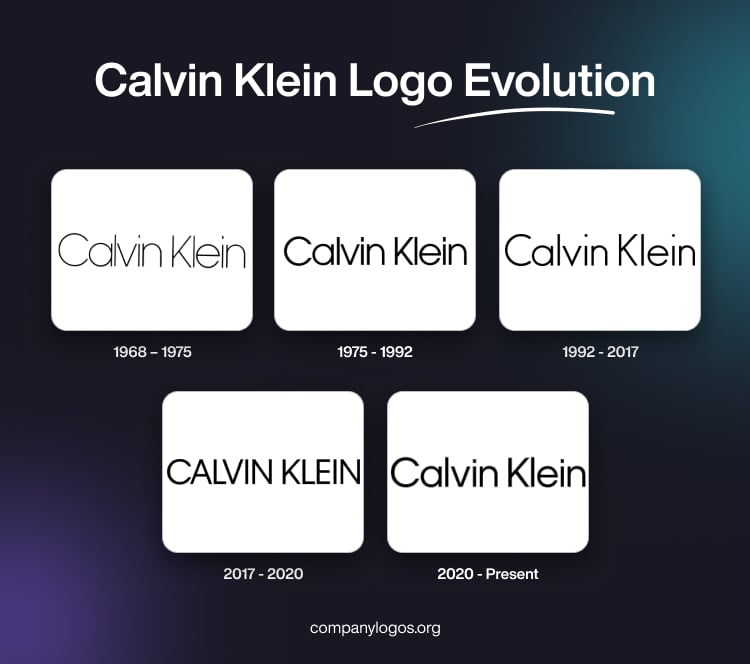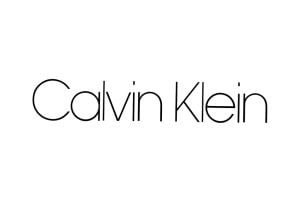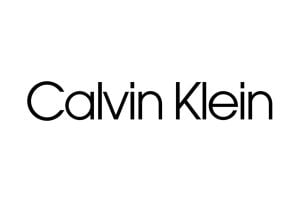
Calvin Klein remains one of the trendsetters in the fashion industry. Founded in 1968, this iconic American fashion brand symbolises elegance, grace, and purity. The brand is well-known for its wide range of products, which include undergarments, shoes, purses, home furnishings, clothes, and fragrances for men and women. This article explores the various logo changes of the Calvin Klein brand, among other details of the company.
The Genesis of the Calvin Klein Logo (1968 – 1975)
The first Calvin Klein logotype was introduced in 1968, the year of its founding. It featured the brand name in a light title case in black against a white background. The elegant black lettering of the logotype was written using a traditional sans-serif typeface, which was similar to the Hess Gothic Round NF and Kontora Light typefaces. The stark black-and-white contrast bestowed the logo with a fresh and exceptionally refined appearance. It helped the logo establish an identity that set it apart from the fashion trends of its era.

(1975 – 1992)
In the first logo change in 1975, the logotype was made stronger and bolder by making the letters thicker. Besides, the typeface chosen was more intense and solid, which was similar to the OL Round Gothic Bold and ITC Avant Garde Gothic Pro Book typefaces.

(1992 – 2017)
Between 1992 and 2017, the Calvin Klein logo design also adopted the “cK” monogram in both lowercase and mixed case. The updated typeface of the Calvin Klein wordmark during this period had a notable resemblance to the Bambino Light font. This evoked a sense of continuity as well as infused a rejuvenating twist into the design.



(2017 – 2020)
The 2017 logo iteration saw the logotype in capital letters and written using the ITC Avant Garde Gothic Pro Book typeface. The closely spaced letters of the logotype made them look condensed and strong.

(2020 – Present)
The current Calvin Klein logo has done away with the uppercase brand name and adopted the 1975 wordmark in a title case using a condensed sans-serif Futura typeface. This bold logotype continues to portray the visual identity of the brand across channels, product lines, and geographies.

The Elements of the Calvin Klein Logo
Font
The brand name that literally forms the logo along with the “ck” monogram is executed in a lightweight sans-serif Futura typeface.
Colour
The Calvin Klein logo is rendered in a combined colour palette of black, grey, and white to symbolise purity, perseverance, elegance, and grace.
The History of Calvin Klein
Calvin Klein was founded in 1968 by an American fashion designer, Calvin Klein, and his business partner, Barry K. Schwartz, in New York City. The brand started modestly, with a small coat shop in the York Hotel in Manhattan. Initially, it focused on clean, understated coats and dresses. Klein’s minimalist aesthetic quickly distinguished the label, and within a year, it was featured on the cover of Vogue, which set the stage for rapid growth.
By the 1970s, Calvin Klein expanded into sportswear, blazers, and lingerie and became one of the first American fashion houses to embrace a more casual yet refined look. The brand became synonymous with the concept of “American minimalism”. It focused on simple and timeless designs over flamboyant fashion trends.
In 1978, Calvin Klein revolutionised the fashion industry by launching designer jeans with his name embroidered on the back pocket. This move marked the beginning of the “designer denim” era. The campaign featured a young Brooke Shields with the famous line, “You want to know what comes between me and my Calvins? Nothing”, which went on to become one of the most iconic and controversial ads in the history of fashion.
The brand quickly became a household name, thanks to the bold and provocative marketing that challenged social norms. In the 1980s, Calvin Klein introduced its now-famous underwear line. It used striking black-and-white campaigns with celebrities and models like Mark Wahlberg (then “Marky Mark”) and Kate Moss. These campaigns turned underwear into a fashion statement.
The 1990s marked the dominance of Calvin Klein as a global fashion powerhouse. The company expanded into fragrances, home collections, and accessories and created a lifestyle brand beyond clothing. The launch of Calvin Klein Obsession (1985), Eternity (1988), and CK One (1994) brought enormous commercial success.
The CK One fragrance was marketed as a gender-neutral scent and was revolutionary at the time and captured the spirit of youth culture. Its minimalistic design and unisex appeal fit perfectly with Klein’s brand identity. The decade also saw Calvin Klein become associated with sensual, edgy advertising that sparked both criticism and acclaim.
Despite its cultural influence, Calvin Klein faced financial difficulties in the late 1990s due to high operational costs and fierce competition. In 2003, the brand was acquired by Phillips-Van Heusen Corporation (PVH Corp.), which also owns other major fashion brands. This acquisition allowed Calvin Klein to stabilise financially and continue expanding globally. During this period, the brand shifted focus to reinforcing its core categories: jeans, underwear, and fragrances, which remained its strongest revenue drivers.
In the 2010s, Calvin Klein worked to modernise its image under new creative directors. Most notably among them was the Belgian designer, Raf Simons, who was known for his avant-garde approach and who joined as Chief Creative Officer in 2016. His tenure brought high fashion credibility and bold new campaigns, but he left in 2018 after mixed commercial results.
Calvin Klein maintains its reputation as a global lifestyle brand, with a presence in more than 100 countries. Its minimalist, clean-cut style continues to resonate with audiences, while provocative advertising remains central to its identity. The brand is particularly strong in denim, underwear, fragrances, and basics, and it continues to adapt to digital marketing and youth culture trends.
Interesting Facts About Calvin Klein
- Calvin Klein started his company in 1968 with only $10,000, a rented showroom space, and a small line of coats. Within a year, he was already featured in Vogue.
- Calvin Klein is credited with inventing the designer jeans craze. In 1978, he added his name to the back pocket of jeans, which instantly transformed denim from workwear into a luxury fashion item.
- In 1980, the 15-year-old Brooke Shields appeared in Calvin Klein’s denim ad with the famous line: “You want to know what comes between me and my Calvins? “Nothing.” The ad was so provocative that it was banned on some TV networks, but it helped sales to skyrocket.
- Calvin Klein underwear was launched in the 1980s, and it turned basics into a fashion statement. Ads featuring Mark Wahlberg (then a rapper known as “Marky Mark”) made the campaign legendary and helped boost the brand’s popularity worldwide.
- In 1994, Calvin Klein released CK One, the world’s first mass-market unisex fragrance. Its clean, minimal packaging and gender-neutral concept resonated with the youth and made it one of the best-selling perfumes of all time.
- From featuring nearly nude models to controversial campaigns with Kate Moss and Justin Bieber, Calvin Klein has often pushed the boundaries of advertising. The brand became famous (and sometimes infamous) for its bold, sensual marketing.
- Calvin Klein’s designs have been worn by countless celebrities, from Gwyneth Paltrow and Julia Roberts to newer stars like Kendall Jenner. The label’s sleek red-carpet gowns reflect its minimalist philosophy.
- In the 1985 movie Back to the Future, Marty McFly (Michael J. Fox) is mistaken for being named “Calvin Klein” because his underwear has the logo printed on it. This pop culture moment gave the brand an unexpected boost in recognition.
- From 2016 to 2018, the Belgian designer Raf Simons served as Chief Creative Officer, which gave Calvin Klein a more avant-garde, high-fashion edge. Although critically praised, it wasn’t as commercially successful.
- Calvin Klein, Inc. was sold to PVH Corp. (Phillips-Van Heusen) in 2003 for around $430 million. PVH also owns Tommy Hilfiger and other major brands, but Calvin Klein remains one of its top revenue earners.
- The brand is widely credited with popularising minimalist fashion in the U.S. It favours clean lines, neutral tones, and simplicity over flashy design trends.
- Calvin Klein products are sold in over 100 countries. Its portfolio spans clothing, accessories, fragrances, and home goods, thereby making it one of the most recognised fashion brands worldwide.
Finally
The way the Calvin Klein logo has changed over time stands as proof of the company’s adaptability and success in the rapidly evolving fashion industry. The Calvin Klein logo has evolved from its modest origins in the late 1960s to its current status as a globally recognised emblem of classic style and cutting-edge refinement.